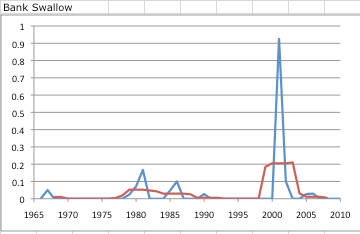Tennessee BBS 5: Larks to Wrens
Horned Lark
 35 year change: -0.34 (-25%) ± 0.45
35 year change: -0.34 (-25%) ± 0.45Numbers of Horned Larks recorded on the BBS in Tennessee appear to have fallen, then risen, and ended up not significantly changed from where they started.
Northern Rough-winged Swallow
 35 year change: +1.87 (+141%) ± 0.79
35 year change: +1.87 (+141%) ± 0.79All five species of swallows recorded on the BBS in Tennessee have shown increases in numbers during the period. In the case of Rough-wings, the increase happened between 1980 and 2000, with some small retreat suggested since then.
Purple Martin
 35 year change: +5.33 (+121%) ± 1.43
35 year change: +5.33 (+121%) ± 1.43The significant increase in Purple Martins has happened primarily since 1995.
Tree Swallow
 35 year change: +0.99 ± 0.25
35 year change: +0.99 ± 0.25As presumed breeders, Tree Swallows were unrecorded on the BBS in Tennessee until 1986; there was one 1973 report that was presumed to be late migrants. Numbers stayed low through 2000, then spiked upwards dramatically to the point that this is now an expected species on many BBS routes across the state.
Bank Swallow
 35 year change: +0.10 (+2063%) ± 0.21
35 year change: +0.10 (+2063%) ± 0.21Bank Swallows are found infrequently and on only a very few BBS routes in Tennessee. The trend in counts has been upwards but this is not statistically significant.
Barn Swallow
 35 year change: +6.30 (+26%) ± 3.53
35 year change: +6.30 (+26%) ± 3.53Barn Swallows are abundant and ubiquitous on Tennessee BBS routes. Their numbers have increased less dramatically than the other swallow species in the area. Though the increase is statistically significant, overall the numbers have generally undulated around a fairly stable level.
Cliff Swallow
 35 year change: +6.24 (+798%) ± 2.96
35 year change: +6.24 (+798%) ± 2.96The increase in Cliff Swallows has mostly happened since 1988 and especially since 1998. As their favored habitat in this area is bridges, the BBS is generally good at detecting them. However, they are also very clumpy in distribution and subject to large shifts from year-to-year in response to bridge construction.
Carolina Chickadee
 35 year change: +5.90 (+117%) ± 1.51
35 year change: +5.90 (+117%) ± 1.51The roughly 2-fold increase in Chickadee numbers occurred entirely before 1990. Since then counts have been roughly stable with perhaps a slight decline
Tufted Titmouse
 35 year change: +8.29 (+75%) ± 1.44
35 year change: +8.29 (+75%) ± 1.44Titmouse numbers have shown a steady modest increase since about 1980.
Red-breasted Nuthatch
 35 year change: +0.12 ± 0.11
35 year change: +0.12 ± 0.11Red-breasted Nuthatches have only been recorded on the Fish Springs BBS route. The marginally significant increase is not necessarily of any larger meaning.
White-breasted Nuthatch
 35 year change: +3.20 (+756%) ± 0.47
35 year change: +3.20 (+756%) ± 0.47White-breasted Nuthatches have increased spectacularly and steadily over the entire BBS period. The average count for the late 20-Aughts was 10-fold higher than the average for the late 1960s.
Brown-headed Nuthatch
 35 year change: +0.02 ± 0.03
35 year change: +0.02 ± 0.03Brown-headed Nuthatches have been spreading dramatically through the Tennessee Valley in eastern Tennessee In recent decades. However, Tennessee BBS routes have only record the species in very small numbers so far. A major spike occurred in 2010; it will be interesting to see what 2011 data show.
Brown Creeper
 35 year change: +0.003 ± 0.006
35 year change: +0.003 ± 0.006Creepers have only been recorded on the high elevation Fish Springs BBS route, and only in a few years.
Carolina Wren
 35 year change: +14.58 (+154%) ± 2.31
35 year change: +14.58 (+154%) ± 2.31The Carolina Wren is another common species that has shown a dramatic and sustained increase in numbers in Tennessee during the BBS era, especially since about 1980. It is now one of the most abundant and numerous species on the BBS in this state.
Bewick's Wren
 35 year change: -0.66 (-100%) ± 0.19
35 year change: -0.66 (-100%) ± 0.19The collapse of eastern Bewick's Wren populations region wide is well known, and the BBS data show it clearly. The species was already in a precipitous decline when the survey began in 1966; by 1979 numbers were reduced to just a small relict. The remaining populations continued a slower decline, last being found on a BBS route in Tennessee in 2005 (which was itself the first record in 7 years). Outside the BBS only a very few Tennessee nesting sites are known to still exist in a small region of the eastern Central Basin.
House Wren
 35 year change: +0.63 (+786%) ± 0.18
35 year change: +0.63 (+786%) ± 0.18House Wren numbers rose very slowly in the early decades of the BBS, then began a rapid climb after 1990.
Winter Wren
 35 year change: +0.01 (+188%) ± 0.02
35 year change: +0.01 (+188%) ± 0.02Winter Wrens are another high elevation species that have been found only on the Fish Springs route. No meaningful trends can be extracted from this meager data.
Tennessee BBS index:
Introduction
1: Waterfowl to Herons
2: Vultures to Doves
3: Cuckoos to Woodpeckers
4: Flycatchers to Corvids
5: Larks to Wrens
Next: 6: Gnatcatchers to Waxwings
7: Wood Warblers
8: Towhees to Buntings
9: Icterids to House Sparrow
Ups and Downs
Habitats
Inflection Points
Summary


0 Comments:
Post a Comment
<< Home